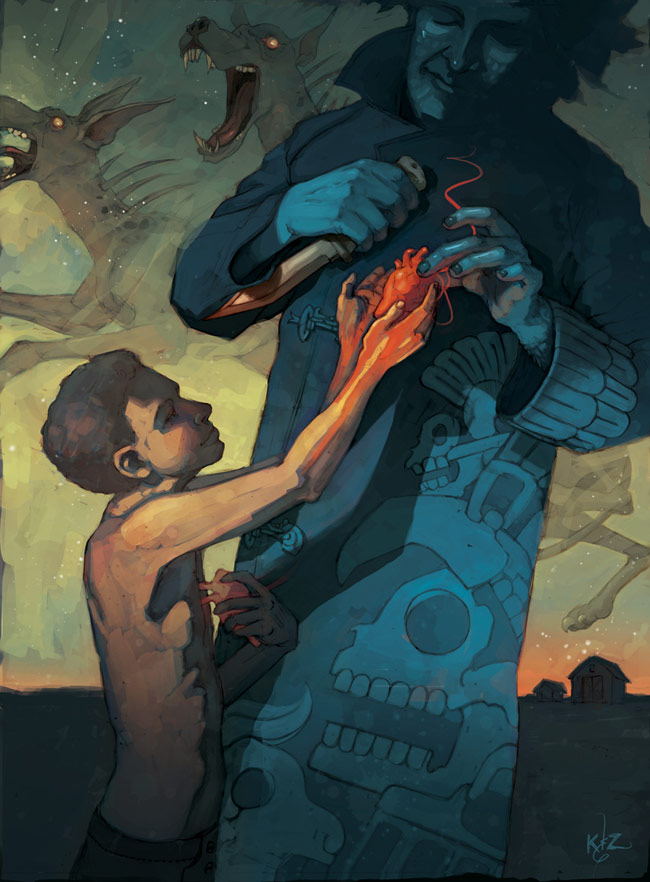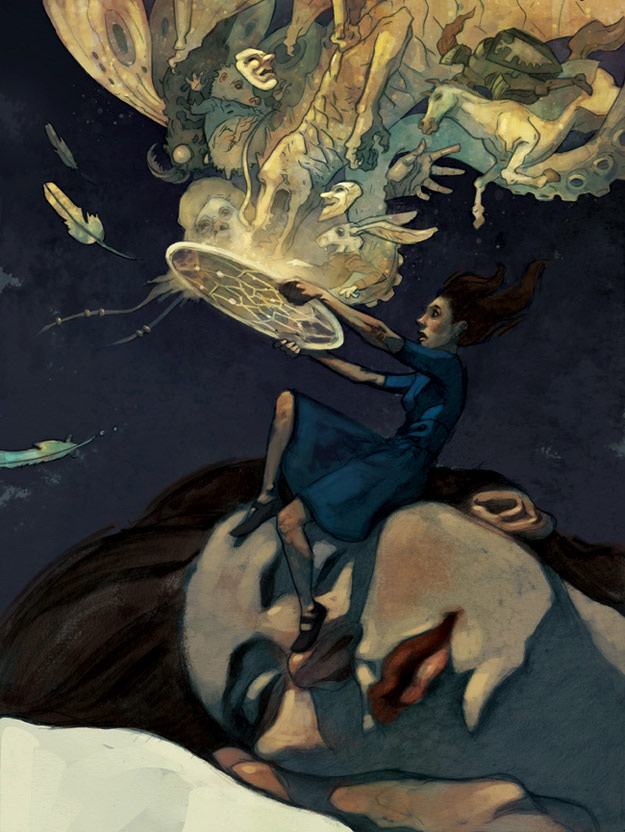I Want To Be… Part Of An Evil Illustrator Duo!

One morning, this email materialised in front of my eyes…
I’d love to share with you (and others) what I do. My boyfriend and I are storytellers. We both work together to achieve the illustrations attached. We came from the world of soul-sucking
advertising. After a few years, we both quit our jobs and moved on to a self-directed, self-aware lifestyle. We make book covers, comics for Vertigo and a whole slew of our own stories for TOR.com.
No more explanation needed. Without further ado, our first career interview of 2011!
Tell us about what you do.
There is two of us; we are Kurt Huggins and Zelda Devon. Together, we bring darkly whimsical stories to life.
For a little over three years, we’ve been working together illustrating luscious things like comics, book covers, album art, magazines, chocolate boxes and anything else that would improve exponentially with an image.
What does an average day at work look like for you?
Our mothers would frown if they knew how late we rise, so that will remain undisclosed. We start the day by making a smoothie stuffed with lots of things that might make a rabbit happy. Our day is saturated with the needs of our current project, which includes plenty of research, trips to the coffee shop, and sweating at the drawing board. This tends to continue so late into the night that birds start chirping. They double as our “it’s bedtime” alarm. We usually focus on one project at a time. A chunk of the day is reserved for sharpening the craft by practicing anatomy, watching demos, reading tutorials, buying books, and bitching to/comforting other illustrators. As deadlines approach, it ramps up into a full steam ahead, don’t-you-dare-invite-me-anywhere-I’ll-eat-your-face-manic mode. Finally, we emerge feeling like we’ve just given birth to a 200 pound hippo. I like those days. Diligent days are followed by “off” days, which include only the minimal tasks of putting on pants and drooling.
Do you work alone or with other people?
Kurt and I have always worked together since becoming professional illustrators. For the first few years, it’s only been the two of us. Lately, we’ve had the excellent fortune of collaborating with some of the top veterans in the industry. With our first issue for Vertigo Comics, Unwritten #12, we got a chance to work with artist Peter Gross and writer Mike Carry. We’ve also worked with many amazing art directors, like Irene Gallo, who push us infinitely further.
Is this what you wanted to do as a child? Did you end up in this job by “accident” or was it a planned career choice?
Yes. Accidentally intentional. Both of us doodled incessantly as tadpoles. Adult life caught up with us and we went to grad school and followed pre-designed career paths, working responsible jobs that offered dental insurance. We were financially secure, but happiness deficient. By chance, Kurt and I found ourselves at a small wooden table in our living room, passing a piece of paper back and forth, taking turns drawing panels. What resulted was the embryo of our first story which we posted on our own little blog. We were proud of it to bits, so we began blissfully posting more little fictions. We were entirely unaware these incipient stories were going to lodge in the hearts of people who could give us jobs. Once the first tentative gig came in, the path was set in motion. We were buckled in and were ready for the roller coaster, never longing for vapid water-cooler conversation again.
How long ago did you start on this path?
We started our blog in March 2006, but it didn’t become our career until July 2007. It was at that point I lost my full time job. I had no desire to go back to the same industry. After a week of hopelessness, I made a list of things I wanted to do. The inventory was 3 pages long. Somewhere hidden in that delirious mound of writing, was a shy scribble of me wanting to be an illustrator. I was 27 at that point. A week after cementing that decision, we got one of our first jobs, drawing a cover for a local magazine. I think making the decision was 90% of the battle. The work started to trickled in, allowing Kurt the opportunity to quit his job 6 months later.
How long were you doing it before you made it into your career or primary form of income?
Our first year, we were eating shoe tongues. When those ran out, we started feeding on the laces. Our second year, we could afford jam for our boot gruel. This past year, we actually had a prosciutto panini with no shoe bits at all. If you give yourself no other option but success, you’re going to succeed. Commit to what you want to do and stick with it. Your decision will come to fruition if you don’t give up.

Did anything significant happen to get you to that point, or was it a series of small steps?
A series of very fortuitous small steps. The first was planting ourselves in New York. Living in New York leads to many advantageous accidents/opportunities/meetings/parties. We were also lucky to have won an award and gained the attention of a respectable rep, Morgan Gaynin. It was validation for the path we chose, which is so vital for a neophyte illustrator.
What kind of education do you have?
We both attended a southern art school that featured moss draped trees, antebellum architecture, a few ghosts, but very little learning.
We left college in a zombie daze, absolutely rudderless. The next logical step; more school. We would only learn, years later, how pivotal that decision was. We chose Portfolio Center, a tiny school tucked away at the end of a pothole-filled street. Our grad school time was a huge foil to the Fisher-Price land we left months before. The experience was just as harrowing as that street; a two year intensive design boot camp, taught only by working professionals who doled out critiques harsher than #50 grit sandpaper. It provided us the ammo we needed to confidently head to NY and dive deep into the world of advertising.
After being in the corporate world for three years, Kurt’s interest in painting and drawing rekindled after he found an atelier to attend. He sandwiched the classes between his usual daytime workload. His skills rapidly improved and I was jealous, so I also began going. We still diligently attend, a few days a week, to continue honing the craft. We also frequent seminars, visit other famous illustrator’s studios and generally have an amazing group of illustrator friends here in New York, which is just as educational as any formal training.
Do you think official qualifications are important for someone entering your industry?
It’s more important to have a deep, unconditional love for the craft and an amazing amount of discipline. The only qualification is wanting to learn. There are several instances of people going from zero drawing skills to extremely competent draftsmanship in a matter of a few years. Living in a inspiration mecca like NY or LA doesn’t hurt, as well as having a lot of blind belief in yourself.
What advice would you give to someone else who might be studying to get into your industry?
Work hard and then work even harder. Get feedback from professionals, and take their advice. Surround yourself with the best in the industry.
Approach being an illustrator as a lifestyle, not a hobby. Do what you love, others will love it, too.
What do you think is the best thing about what you do?
Bringing inspiration to others. Experiencing flow: a magic period where everything aligns and you know exactly what to do next. Flow happens when the greatest amount of challenge is met with the most amount of skill.
The state of flow is the best drug in the world. Seeing an extensive project come to fruition.
Not attending pointless meetings, and working on top of each other.
What’s the worst thing?
Handling slow periods, both monetarily and psychologically. Achieving self-discipline, combined with the struggle of two egos working on top of each other.
Would you call yourself a workaholic, & if so, are you alright with that? Do you think that’s normal for your industry?
If you love what you do, it’s impossible to not be a workaholic. It’s darn addictive. And yes, I’d say it is a common aspect of our industry.
What do you wish you had known when you first started out?
None of it, if we knew how grueling it would be, we might never have started.
Remaining blissfully unaware is sometimes a great boon.
Are there any major misconceptions about your job or industry?
Very few people hit the ground running at the beginning. There are exceptions, but for the majority of people it’s going to take time to reach a professional level and then a little longer to break in. Again, the amount of dedication required is astounding. It’s way more energy than a full time job.

What is the best thing that’s happened to you as a consequence of the work you do?
A realization that you can navigate your reality as if it were a ship, steering it in your chosen direction. Basking in the side effects of flow.
Appreciating how far sheer determination will get you.
What motivates you to keep doing what you’re doing?
The satisfaction of doing a good job, the little discoveries while practicing the craft, the exhilaration of fan mail from people we’ve long admired. It all adds up to bringing people visual joy.
Who do you look up to within your industry & why?
Oh, jeeze, my fingers might get tired: Mike Mignola, Joaquin Sorolla, J.C. Leyendecker, Arthur Rackham, Edmund Dulac, Sam Weber, Heinrich Kley, Hayao Miazaki, Alphonse Mucha, Ivan Bilibin, John Singer Sargent, Alex Kanevsky, Claire Wendling, Matthieu Lauffray, Massimo Carnevale, Frank Brangwyn, Dean Cornwell, Milt Kahl, Yoshida Hiroshi, Sergio Martinez, Franklin Booth, and Paul Felix. A few who are not even illustrators, like Alexander McQueen and Guy Hendrix Dyas.
Is there much career progression available to you? What would you like to do next?
As an illustrator, you’re at the helm of your own progression. Also, doing work gets you work, it’s the absolute best form of advertising.
The next step could involve influencing film or animation, which would be a huge rush.
Do you think you’ll continue doing this for the rest of your life?
Yes, we’re already neck-deep in this. It is a fluid career with many forking paths and there’s so much to explore.
The ideal is to keep working, continue growing, and never retire.
